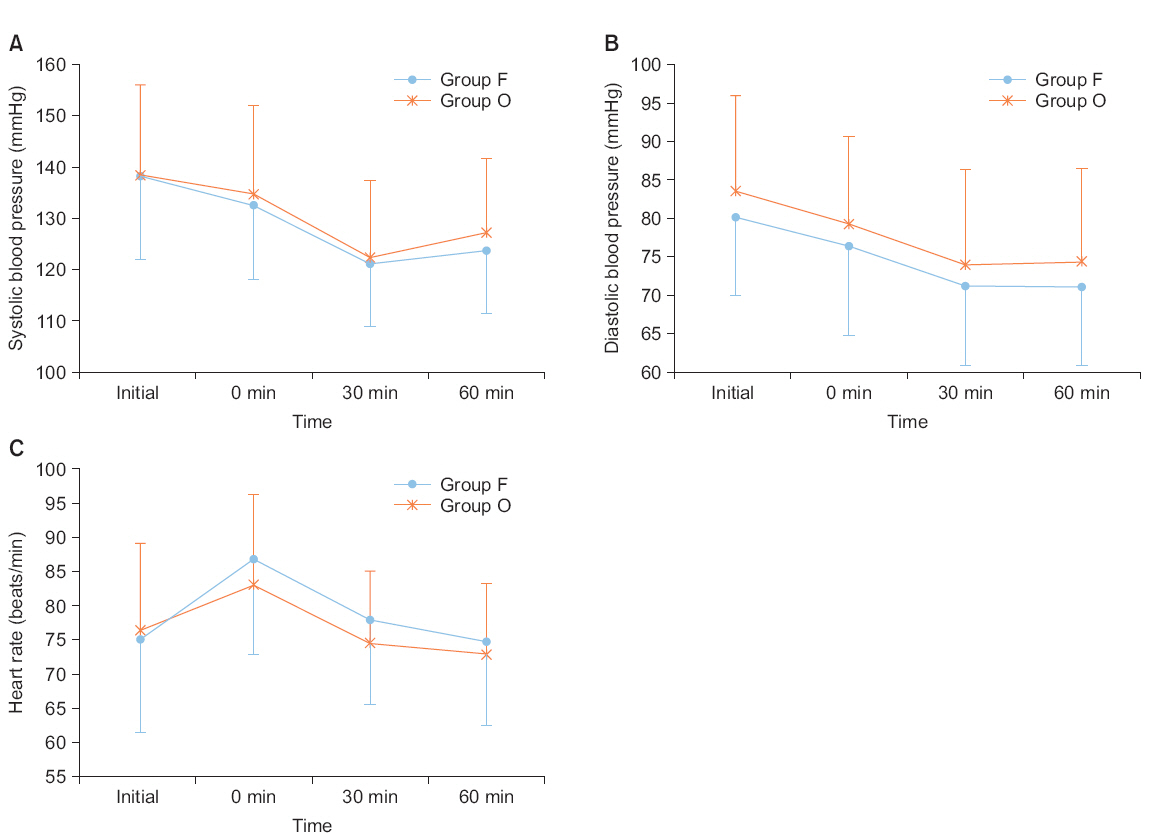Anesth Pain Med.
2018 Oct;13(4):394-400. 10.17085/apm.2018.13.4.394.
Comparison of the analgesic efficacy of oxycodone and fentanyl after dental surgery
- Affiliations
-
- 1Department of Anesthesiology and Pain Medicine, School of Medicine, Kyungpook National University, Daegu, Korea. pine253@hanmail.net
- KMID: 2435997
- DOI: http://doi.org/10.17085/apm.2018.13.4.394
Abstract
- BACKGROUND
Oxycodone is a strong m-opioid receptor agonist and has a longer duration of analgesic effect than fentanyl. We compared the use of an intravenous (IV) bolus of oxycodone and fentanyl for postoperative analgesic efficacy after dental surgery.
METHODS
Patients underwent surgical extraction under general anesthesia. We prospectively enrolled patients who had received IV oxycodone (n = 36, 0.05 mg/kg) and fentanyl (n = 36, 1 mg/kg) 10 minutes before the end of surgery. The recovery profiles (hemodynamic variables, pain score, postoperative nausea and vomiting, sedation scale, and adverse events) were recorded for 1 hour in the post-anesthetic care unit (PACU) and at 6 hours after surgery.
RESULTS
Under a potency ratio of 50:1 (oxycodone:fentanyl), time to spontaneous ventilation was significantly longer in the oxycodone group (8.1 ± 2.8 min vs. 6.9 ± 1.8 min, P = 0.021). The overall pain scores were significantly lower in the oxycodone than in the fentanyl group (P < 0.001), and the oxycodone group had significantly fewer additional analgesic requirements in the PACU than the fentanyl group (8.3% vs. 27.8%, P = 0.032). The incidence of postoperative nausea and sedation were comparable in both groups. No opioid-related adverse event was identified.
CONCLUSIONS
In dental surgery, 0.05 mg/kg IV oxycodone had a longer-lasting analgesic effect than that of 1 µg/kg IV fentanyl, and could reduce total opioid consumption without increasing side effects. Patients experienced satisfactory analgesia postoperatively; thus, oxycodone is an effective opioid analgesic for acute postoperative pain relief.
Keyword
MeSH Terms
Figure
Reference
-
REFERENCE
1. McQuay H. Opioids in pain management. Lancet. 1999; 353:2229–32. DOI: 10.1016/S0140-6736(99)03528-X.2. Raeder J. Opioids in the treatment of postoperative pain:old drugs with new options? Expert Opin Pharmacother. 2014; 15:449–52. DOI: 10.1517/14656566.2014.879292. PMID: 24437530.3. Koch S, Ahlburg P, Spangsberg N, Brock B, Tønnesen E, Nikolajsen L. Oxycodone vs. fentanyl in the treatment of early post-operative pain after laparoscopic cholecystectomy:a randomised double-blind study. Acta Anaesthesiol Scand. 2008; 52:845–50. DOI: 10.1111/j.1399-6576.2008.01643.x. PMID: 18477082.4. Park JH, Lee C, Shin Y, An JH, Ban JS, Lee JH. Comparison of oxycodone and fentanyl for postoperative patient-controlled analgesia after laparoscopic gynecological surgery. Korean J Anesthesiol. 2015; 68:153–8. DOI: 10.4097/kjae.2015.68.2.153. PMID: 25844134. PMCID: PMC4384403.5. Bodian CA, Freedman G, Hossain S, Eisenkraft JB, Beilin Y. The visual analog scale for pain:clinical significance in postoperative patients. Anesthesiology. 2001; 95:1356–61. DOI: 10.1097/00000542-200112000-00013. PMID: 11748392.6. Choi YJ, Park SW, Kwon HJ, Choi JM, Lee YM. Efficacy of early intravenous bolus oxycodone or fentanyl in emergence from general anaesthesia and postoperative analgesia following laparoscopic cholecystectomy:a randomized trial. J Int Med Res. 2015; 43:809–18. DOI: 10.1177/0300060515594194. PMID: 26378067.7. Choi BM. A new therapeutic option for postoperative pain management with oxycodone HCI injection. Korean J Anesthesiol. 2016; 69:211–8. DOI: 10.4097/kjae.2016.69.3.211. PMID: 27274364. PMCID: PMC4891531.8. Hwang BY, Kwon JY, Kim E, Lee DW, Kim TK, Kim HK. Oxycodone vs. fentanyl patient-controlled analgesia after laparoscopic cholecystectomy. Int J Med Sci. 2014; 11:658–62. DOI: 10.7150/ijms.8331. PMID: 24843313. PMCID: PMC4025163.9. Urquhart E. Analgesic agents and strategies in the dental pain model. J Dent. 1994; 22:336–41. DOI: 10.1016/0300-5712(94)90084-1.10. Litkowski LJ, Christensen SE, Adamson DN, Van Dyke T, Han SH, Newman KB. Analgesic efficacy and tolerability of oxycodone 5 mg/ibuprofen 400 mg compared with those of oxycodone 5 mg/acetaminophen 325 mg and hydrocodone 7.5 mg/acetaminophen 500 mg in patients with moderate to severe postoperative pain:a randomized, double-blind, placebo-controlled, single-dose, parallel-group study in a dental pain model. Clin Ther. 2005; 27:418–29. DOI: 10.1016/j.clinthera.2005.04.010. PMID: 15922815.11. Averbuch M, Katzper M. Baseline pain and response to analgesic medications in the postsurgery dental pain model. J Clin Pharmacol. 2000; 40:133–7. DOI: 10.1177/00912700022008775. PMID: 10664918.12. Minami K, Hasegawa M, Ito H, Nakamura A, Tomii T, Matsumoto M, et al. Morphine, oxycodone, and fentanyl exhibit different analgesic profiles in mouse pain models. J Pharmacol Sci. 2009; 111:60–72. DOI: 10.1254/jphs.09139FP. PMID: 19729873.13. Kalso E. Oxycodone. J Pain Symptom Manage. 2005; 29:S47–56. DOI: 10.1016/j.jpainsymman.2005.01.010. PMID: 15907646.
- Full Text Links
- Actions
-
Cited
- CITED
-
- Close
- Share
- Similar articles
-
- A new therapeutic option for postoperative pain management with oxycodone HCI injection
- Oxycodone versus Fentanyl for Intravenous Patient-Controlled Analgesia after Laparoscopic Gynecologic Surgery
- Oxycodone vs. fentanyl in the treatment of early post-operative pain after total knee replacement: randomized controlled trial
- Comparison of oxycodone and fentanyl for postoperative patient-controlled analgesia after orthopedic surgery
- A comparison of oxycodone and fentanyl in the management of early postoperative pain and for patient-controlled analgesia after total abdominal hysterectomy



